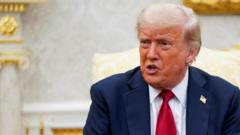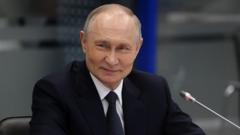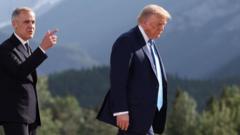Amid escalating missile threats from global powers, President Donald Trump has introduced the 'Golden Dome' concept, a next-generation missile defense system, promising enhanced protection at significant costs and complexities. Experts raise concerns regarding its practicality and potential to ignite an arms race.
Trump Proposes Ambitious 'Golden Dome' Defense Initiative Amid Rising Global Threats

Trump Proposes Ambitious 'Golden Dome' Defense Initiative Amid Rising Global Threats
The proposed 'Golden Dome' missile defense system aims to protect the United States against advanced missile threats, but its feasibility and cost remain contentious.
The threat of high-tech military confrontations hangs heavy over the United States as President Donald Trump proposes an ambitious new defense initiative dubbed the 'Golden Dome.' This missile defense system is designed to preemptively counter advanced threats such as intercontinental ballistic missiles (ICBMs) and hypersonic weapons deployed by adversaries like Russia and China. Experts suggest that without such an upgrade, the U.S. could face catastrophic consequences in a potential high-tech conflict.
The initiative comes in response to increasing concerns regarding the state of the U.S.'s current defense capabilities, which many contend are outdated in the face of evolving threats. A single nuclear detonation, experts assert, could unleash electromagnetic pulses (EMPs) rendering critical infrastructure inoperable across vast swathes of the country. “It would be akin to going back 1,000 years,” warned weapons researcher William Fortschen, illuminating the dire need for enhanced missile defenses.
The 'Golden Dome' seeks to establish a comprehensive shield against these threats, as delineated in an executive order that highlights the intensified risk posed by emerging missile technologies. The initiative aims to develop a sophisticated multi-layered defense architecture, potentially incorporating space-based sensors and interceptors, a drastic shift from the existing systems focused mainly on ICBMs.
While defense officials have begun laying the groundwork for the 'Golden Dome,' details remain scarce. Initial estimates place the project at an ambitious cost of $175 billion, although analysts foresee the actual expenses could far exceed this figure. The Congressional Research Office estimates that establishing robust space-based defenses alone may balloon to upwards of $542 billion over two decades.
Critics point to the complexities in integrating diverse systems to address current and future missile threats. Stacie Pettyjohn, a defense expert, cautioned that rushing the development could lead to inefficiencies and potential system failures. Additionally, the emergence of the 'Golden Dome' raises concerns about triggering an arms race, with adversaries quick to respond and enhance their offensive capabilities.
Similar to Israel’s Iron Dome, designed for shorter-range threats, the U.S. 'Golden Dome' aspires to cover a broader spectrum of threats, potentially deterring adversaries by enhancing the protection of American territory. Gene Bazylczyk, a missile defense expert, expressed that even a partially complete 'Golden Dome' initiative could significantly bolster deterrence.
The future of this defense project now hinges on its feasibility, financial implications, and strategic effectiveness, as the world watches closely to see if the 'Golden Dome' can evolve from concept to reality whilst fostering global stability amidst rising tensions.




















